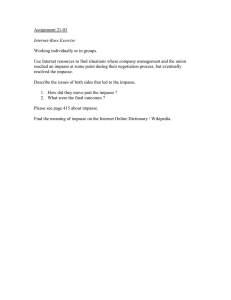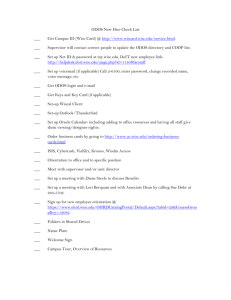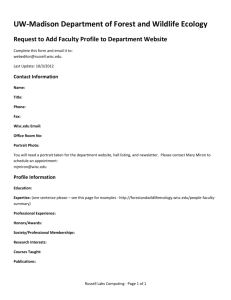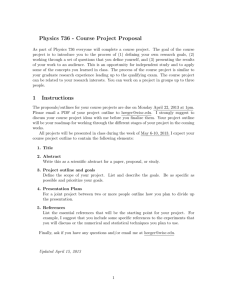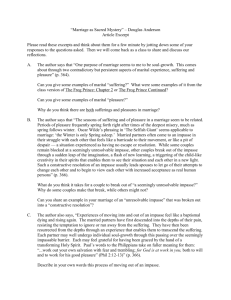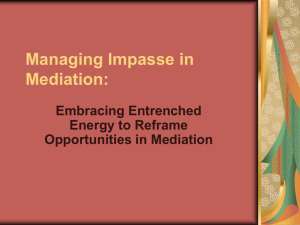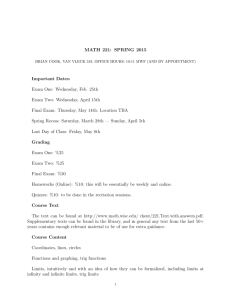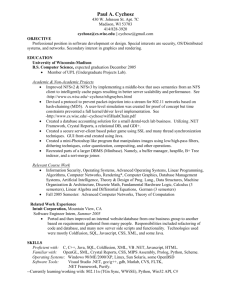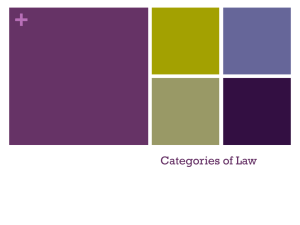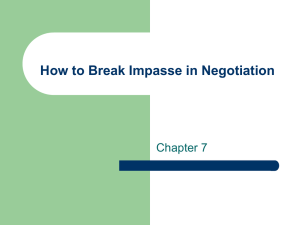“Group Dynamics and Conflict Management” Workshop for Student
advertisement
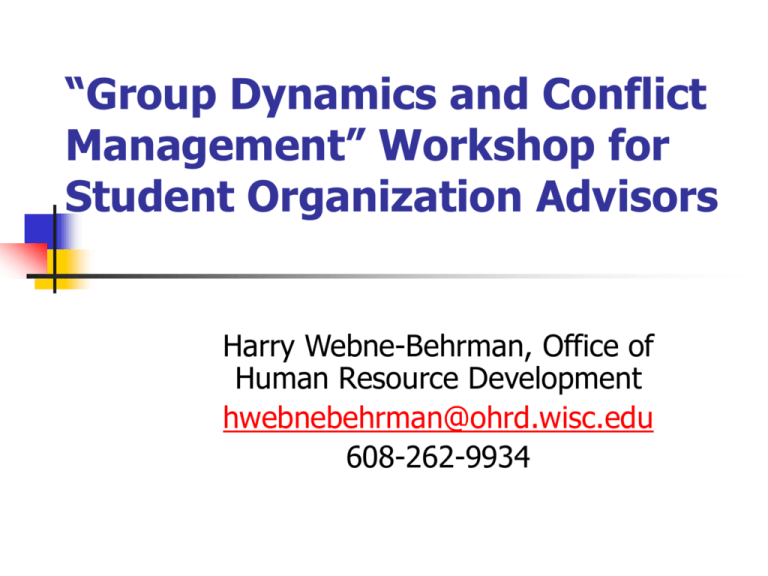
“Group Dynamics and Conflict Management” Workshop for Student Organization Advisors Harry Webne-Behrman, Office of Human Resource Development hwebnebehrman@ohrd.wisc.edu 608-262-9934 Welcome! So, what does this description mean to you? …this workshop is designed to help student organization advisors work with their students in healthy and productive ways. Specifically, participants will review what are common group dynamics and strategies for maintaining healthy group dynamics. In addition, participants will learn how to deal with inevitable conflict within their student organizations. Where should we focus our time and energy this evening? What do we know? What works? Quick Interview: Describe an experience in which you were the student (or mentee) and had a highly constructive relationship with your advisor (mentor). What stands out about that experience? What were some of the strengths of that advising relationship? Group Development True Community Emptying Factions Pseudo-community Scott Peck, The Different Drummer, 1987 Four Quadrants of Group Facilitation (Davis, Harris, and Webne-Behrman) SELF GROUP/ORG. CULTURE TASK/PLAN GROUP/ORG. OUTCOME What does this mean for you? Connect back to issues raised earlier Groups (and relationships) go through stages of development Interactions among participants are often complex (as discerned from simple or complicated) and emergent Advisors need to find effective ways to help manage both interior (beliefs, values, capacity, culture) and exterior (tasks, plans, outcomes, production) in the group’s process Apply What You’ve Just Learned… Reflect upon what you’ve just learned. Consider: Goal – What are you trying to accomplish with your student group? Reality – What is happening now? Where are you in relation to your goal? Options – What opportunities are available to you? What obstacles (interior, exterior) appear to exist? What Next? – What can you apply from your insights thus far? What else do you need to know in order to answer this question? GROW Coaching Model adapted from the work of Graham Alexander and Sir John Whitmore, and others. Addressing Challenging Issues: Conflict Resolution Strategies Facilitating the resolution of conflicts within groups is critical at all phases Integrate skills: Communication (Listening/ Asserting) Interest-based Negotiation Problem-Solving and Analysis Consensus-building Needs in Negotiation psychological substantive procedural Needs in Negotiation Substantive needs = the “stuff” of the conflict… typical definition of problem Procedural needs = how we foster a fair and well understood process… “Ground Rules” Psychological needs = concerning trust, honesty, safety, security, integrity Conflict Resolution Process Overview (Inside the Paradox) Focus on each stage as an opportunity to exercise leadership: What are my personal strengths as I look at the elements of this process? Where do I need assistance in order to improve? How might I facilitate such behaviors in my groups? How might I model such approaches? Where are there ‘teachable moments’ from which all of us may learn together? How might we support one another in improving our capacity to manage conflicts effectively? Addressing Conflictive Issues within Groups Pre-Negotiation Understanding and Clarifying Issues Exploring Options with Respect and Flexibility Managing Impasse… Hanging out in the “Groan Zone” of Ambiguity and Uncertainty Convergence – Building Effective Agreements Implementation, Assessment and Feedback Pre-Negotiation Clarify needs of various participants Understand individual ‘agendas’ Negotiate for the process and the role of the facilitator Build an initial meeting agenda that emerges from participants’ needs and interests, dovetailing with group goals Understanding & Clarifying Issues Be Present – Know your Biases and Hot Buttons Actively Listen – seek deeper meaning Persistently focus and convey emerging understandings Assert for the process of the group Explore Options with Flexibility and Respect Focus on Underlying Needs, Interests and Concerns Generate Options Clarify Criteria Encourage Flexibility and Model it Leadership Questions: How flexibly do we approach challenging issues… are we open to new approaches and innovative solutions? Facilitating Through the “Groan Zone” (from Sam Kaner, Managing Impasse… Hanging out in the “Groan Zone” of Ambiguity and Uncertainty Set aside the issue and “name the impasse” Review definition of the problem Shift from substantive to procedural needs Reiterate “ground rules” Look at BATNA… Consider a structured break Treat the impasse with respect Leadership Question: Do we treat impasse with respect or do we try to minimize it or abandon the process when confronting it? This is one of the core challenges of leadership… Convergence – Building Effective Agreements Patiently address all key issues Review the agreement for clarity Look for “Hallmarks” of a good agreement Leadership Question: Can we make the time available to our students to really work through the meaningful issues that get us bogged down? Hallmarks of a Good Agreement Fair Balanced Realistic Responds to Needs of the Conflict Specific Enough As self-enforcing as possible Future-oriented Implementation, Assessment and Feedback Do all you can to implement the Agreement Arrange a time to meet together and review the Agreement: Did we follow through with the agreement? Is it working? How can it be improved? Are there any additional areas of concern? Scenario Scenario (built from survey information) De-brief What did you learn? How might you apply it to your work with students? Keys to Success: Communicating with Integrity Identify Key stakeholders involve them in framing the issues to be addressed Provide easy access to relevant information Establish clear channels of communication that are appropriate to the decision-making style Utilize multiple modes of ongoing reports to stakeholders, as well as relevant ‘public’ Facilitative Leadership Focus on the process – “If you build it, they Monitor underlying needs and concerns of all staff – Create channels for open, honest & will come.” routine communication Provide information reduce anxiety Manage the transitions… help people mark the ‘endings’ and navigate the ‘neutral zone’ towards a new beginning Attend to coordinating resources that support a ‘healthy organization’ Additional Resources Effective Meetings site: http://www.ohrd.wisc.edu/acade micleadershipsupport/howto1.htm Conflict Resolution Skills site: http://www.ohrd.wisc.edu/onlinet raining/resolution/index.htm Questions? Please feel free to follow-up at hwebnebehrman@ohr.wisc.edu or 608-262-9934 ***Please provide feedback, as well***
